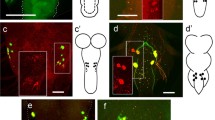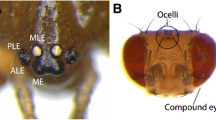Abstract
Analysis of early neurogenesis in the spider Cupiennius salei (Chelicerata, Aranea, Ctenidae) has shown that the cells of the central nervous system are recruited from clusters of cells that invaginate from the neuroectoderm. This is in contrast to Drosophila, where only single cells delaminate and become neuroblasts, the stem cells of the nervous system. In order to compare the processes further, we have cloned homologues of the pan-neural Drosophila genes prospero and snail from the spider and have analysed their RNA and protein expression pattern. We find that snail expression is transient and only a subset of neural cells expresses Snail protein at any given time, making it difficult to assess whether it is indeed a pan-neural gene in the spider. Prospero protein expression, on the other hand, is seen in all invaginating cells and continues throughout differentiation of the neurons. In contrast to Drosophila, asymmetric localization cannot be detected, even in cells that still divide. Our results provide no evidence for neuroblasts or stem cells in the spider, although there are a limited number of mitoses in the cells that are derived from the invaginating clusters. These aspects of spider neurogenesis are more similar to the neurogenesis process known from vertebrates.









Similar content being viewed by others
References
Akiyama-Oda Y, Hotta Y, Tsukita S, Oda H (2000) Mechanisms of glia-neuron cell-fate switch in the Drosophila thoracic neuroblast 6–4 lineage. Development 127:3513–3522
Alberga A, Boulay JL, Kempe E, Dennefeld C, Haenlin M (1991) The snail gene required for mesoderm formation in Drosophila is expressed dynamically in derivates of all three germ layers. Development 111:983–992
Ashraf SI, Ip YT (2001) The Snail protein family regulates neuroblast expression of inscuteable and string, genes involved in asymmetry and cell division in Drosophila. Development 128:4757–4767
Ashraf SI, Hu X, Roote J, Ip YT (1999) The mesoderm determinant snail collaborates with related zinc-finger proteins to control Drosophila neurogenesis. EMBO J 18:6426–6438
Bate CM (1976) Embryogenesis of an insect nervous system. I. A map of the thoracic and abdominal neuroblasts in Locusta migratoria. J Embryol Exp Morphol 35:107–123
Broadus J, Fuerstenberg S, Doe CQ (1998) Staufen-dependent localization of prospero mRNA contributes to neuroblast daughter-cell fate. Nature 391:792–795
Bürglin TR (1994) A Caenorhabditis elegans prospero homologue defines a novel domain. Trends Biochem Sci 19:70–71
Cai Y, Chia W, Yang X (2001) A family of snail-related zinc finger proteins regulates two distinct and parallel mechanisms that mediate Drosophila neuroblast asymmetric divisions. EMBO J 20:1704–1714
Chu-Lagraff Q, Wright DM, McNeil LK, Doe CQ (1991) The prospero gene encodes a divergent homeodomain protein that controls neuronal identity in Drosophila. Dev Suppl 2:79–85
Damen WG, Tautz D (1998) A Hox class 3 orthologue from the spider Cupiennius salei is expressed in a Hox-gene-like fashion. Dev Genes Evol 208:586–590
Doe CQ (1992) Molecular markers for identified neuroblasts and ganglion mother cells in the Drosophila central nervous system. Development 116:855–863
Doe CQ, Goodman CS (1985a) Early events in insect neurogenesis. I. Development and segmental differences in the pattern of neuronal precursor cells. Dev Biol 111:193–205
Doe CQ, Goodman CS (1985b) Early events in insect neurogenesis. II. The role of cell interactions and cell lineage in the determination of neuronal precursor cells. Dev Biol 111:206–219
Doe CQ, Chu-LaGraff Q, Wright DM, Scott MP (1991) The prospero gene specifies cell fates in the Drosophila central nervous system. Cell 65:451–464
Doe CQ, Fuerstenberg S, Peng CY (1998) Neural stem cells: from flys to vertebrates. J Neurobiology 36:111–127
Dove H, Stollewerk A (2003) Comparative analysis of neurogenesis in the myriapod Glomeris marginata (Diplopoda) suggests more similarities to chelicerates than to insects. Development 130:2161–2171
Freeman MR, Doe CQ (2001) Asymmetric Prospero localization is required to generate mixed neuronal/glial lineages in the Drosophila CNS. Development 128:4103–4112
Fuse N, Hirose S, Hayashi S (1996) Determination of wing cell fate by the escargot and snail genes in Drosophila. Development 122:1059–1067
Gerberding M (1997) Germ band formation and early neurogenesis of Leptodora kindti (Cladocera): first evidence for neuroblasts in the entomostracan crustaceans. Invert Reprod Dev 32:63–73
Glasgow E, Tomarev SI (1998) Restricted expression of the homeobox gene Prox1 in developing zebrafish. Mech Dev 76:175–178
Grosshans J, Wieschaus E (2000) A genetic link between morphogenesis and cell division during formation of the ventral furrow in Drosophila. Cell 101:523–531
Hartenstein V, Campos-Ortega JA (1984) Early neurogenesis in wildtype Drosophila melanogaster. Roux’s Arch Dev Biol 196:473–485
Hassan B, Li L, Bremer KA, Chang W, Pinsonneault J, Vaessin H (1997) Prospero is a panneural transcription factor that modulates homeodomain protein activity. Proc Natl Acad Sci USA 94:10991–10996
Hirata J, Nakagoshi H, Nabeshima Y, Matsuzaki F (1995) Asymmetric segregation of the homeodomain protein Prospero during Drosophila development. Nature 377:627−630
Knoblich JA, Jan LY, Jan YN (1995) Asymmetric segregation of numb and prospero during cell division. Nature 377:624–626
Li L, Vaessin H (2000) Pan-neural Prospero terminates cell proliferation during Drosophila neurogenesis. Genes Dev 14:147–151
Matsuzaki F, Koizumi K, Hama C, Yoshioka T, Nabeshima Y (1992) Cloning of the Drosophila prospero gene and its expression in ganglion mother cells. Biochem Biophys Res Commun 182:1326–1332
Oliver G, Sosa-Pineda B, Geisendorf S, Spana EP, Doe CQ, Gruss P (1993) Prox 1, a prospero-related homeobox gene expressed during mouse development. Mech Dev 44:3–16
Retzlaff M (1996) Vergleichende Analyse von Entwicklungsgenen bei verschiedenen Arthropoden unter besonderer Berücksichtigung von Cupiennius salei (Araneae: Ctenidae). Doktorarbeit, Universität München, Munich
Scholtz G (1992) Cell lineage studies in the crayfish Cherax destructor (Crustacea, Decapoda): germ band formation, segmentation and early neurogenesis. Roux’s Arch Dev Biol 202:36–48
Schoppmeier M, Damen WG (2001) Double-stranded RNA interference in the spider Cupiennius salei: the role of Distal-less is evolutionarily conserved in arthropod appendage formation. Dev Genes Evol 211:76–82
Sommer R, Retzlaff M, Goerlich K, Sander K, Tautz D (1992) Evolutionary conservation pattern of zinc-finger domains of Drosophila segmentation genes. Proc Natl Acad Sci USA 89:10782–10786
Spana EP, Doe CQ (1995) The prospero transcription factor is asymmetrically localized to the cell cortex during neuroblast mitosis in Drosophila. Development 121:3187–3195
Stollewerk A (2002) Recruitment of cell groups through Delta/Notch signalling during spider neurogenesis. Development 129:5339–5348
Stollewerk A, Weller M, Tautz D (2001) Neurogenesis in the spider Cupiennius salei. Development 128:2673–2688
Stollewerk A, Tautz D, Weller M (2003) Neurogenesis in the spider: new insights from comparative analysis of morphological processes and gene expression patterns. Arthropod Struct Dev (in press)
Tomarev SI, Sundin O, Banerjee-Basu S, Duncan MK, Yang JM, Piatigorsky J (1996) Chicken homeobox gene Prox 1 related to Drosophila prospero is expressed in the developing lens and retina. Dev Dyn 206:345–367
Torii M, Matsuzaki F, Osumi N, Kaibuchi K, Nakamura S, Casarosa S, Guillemot F, Nakafuku M (1999) Transcription factors mash-1 and Prox-1 delineate early steps in differentiation of neural stem cells in the developing central nervous system. Development 126:443–456
Truman JW, Ball EE (1998) Patterns of embryonic neurogenesis in a primitive wingless insect, the silverfish, Ctenolepsima longicaudata: comparison with those seen in flying insects. Dev Genes Evol 208:357–368
Vaessin H, Grell E, Wolff E, Bier E, Jan LY, Jan YN (1991) prospero is expressed in neuronal precursors and encodes a nuclear protein that is involved in the control of axonal outgrowth in Drosophila. Cell 67:941–953
Whitington PM (1995) Conservation versus change in early axonogenesis in arthropod embryos: a comparison between myriapods, crustaceans and insects. In: Breidbach O, Kutsch W (eds) The nervous system of invertebrates: an evolutionary and comparative approach. Birkhäuser, Berlin, pp 181–219
Acknowledgements
We thank Wim Damen and Ernst Seyfarth for providing the spiders and Monika Retzlaff for providing the Cs-snail clone. We are also grateful to Wim Damen, Michael Schoppmeier and Angelika Stollewerk for techniques, know-how and discussion and Angelika Stollewerk for comments on the manuscript. This work was supported by the Deutsche Forschungsgemeinschaft, Schwerpunktprogramm, “Evolution entwicklungsbiologischer Prozesse” (Ta99/15).
Author information
Authors and Affiliations
Corresponding author
Additional information
Edited by P. Simpson
Rights and permissions
About this article
Cite this article
Weller, M., Tautz, D. Prospero and Snail expression during spider neurogenesis. Dev Genes Evol 213, 554–566 (2003). https://doi.org/10.1007/s00427-003-0362-4
Received:
Accepted:
Published:
Issue Date:
DOI: https://doi.org/10.1007/s00427-003-0362-4




